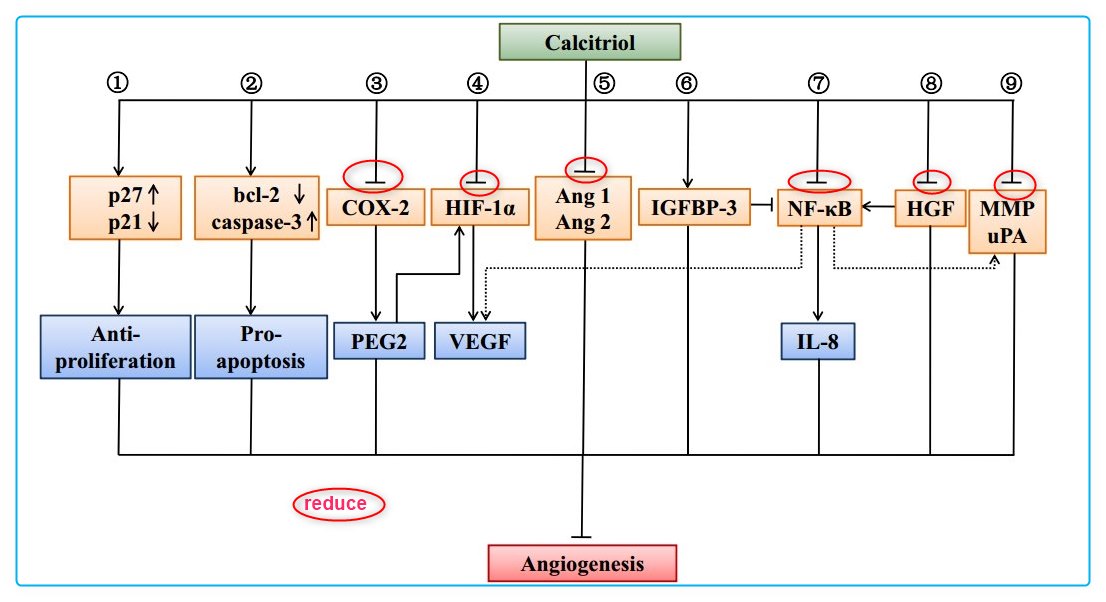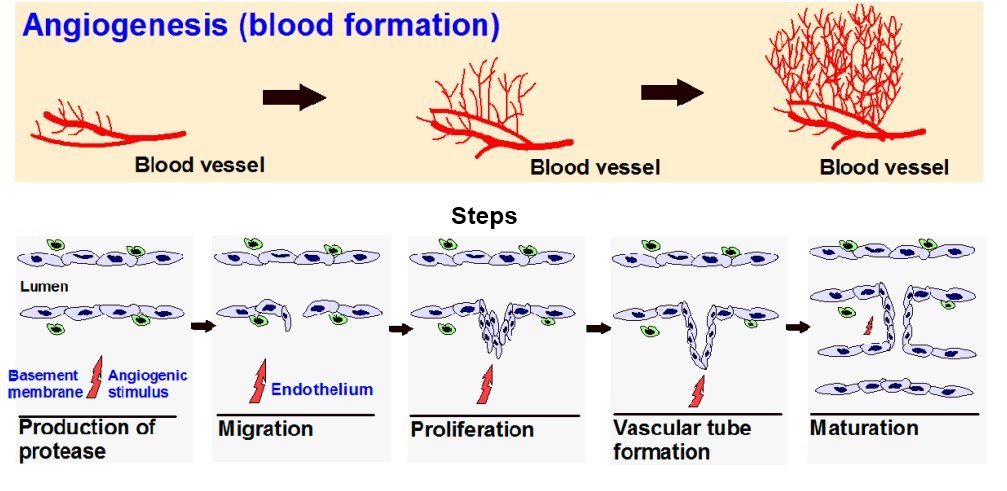Vitamin D restricts new capillary growth (angiogenesis) in fat and cancers
Also restricted by some foods and drugs
Targeting Angiogenesis to Lose Weight - Dr. Greger video and transcript July 2023
Angiogenesis is the creation of blood new vessels. Tumors use it to keep growing. Well, our fatty tissue also needs a blood supply to expand. So, might an anti-angiogenic approach work for weight loss, too? I’ll explore that in this video and the next.
Many of our modern front-line therapies against cancer incorporate “anti-angiogenesis” strategies, from the Greek words angio-, meaning vessel, and genesis, meaning creation. So, anti-angiogenesis is opposing the creation of blood vessels. In other words, fighting cancer by cutting off tumor supply lines.
Some cancers are only able to grow to about the size of the tip of a ballpoint pen without a blood supply. Tumor growth then stalls. Autopsy studies show that virtually everyone has these tiny tumors in them by age 70. Cancer-without-disease can, therefore, be considered the normal state during aging.
To commandeer a blood supply, tumors diabolically release angiogenic factors, chemicals that cause new blood vessels to sprout toward the cancer. Once a blood vessel reaches the tumor and attaches, it’s off to the races—the tumor can then take off exponentially. By starving cancer of its blood supply, chemotherapy that blocks this process can sometimes cause tumors to shrink. But ideally, we wouldn’t have to wait until such a late stage to nip them in the bud. That’s where our diet can come in. Many of the phytonutrients we know and love in tea, spices, berries, broccoli, and beans have anti-angiogenic properties. Given the power of plants, the foundation of an anti-angiogenic approach to cancer has been considered a whole food plant-based diet.
But the title of this video is, “Targeting angiogenesis to lose weight.” What does this have to do with obesity? Well, think about it. Tumors aren’t the only tissue in the body with expanding volume. The average tumor picked up by mammograms is only about the size of a marble, and it can take breast cancer decades to grow. Whereas, overfeed people, and you can easily add an entire pound of fatty tissue in a matter of days. And, body fat is highly vascularized. Each fat cell in our body is essentially surrounded by tiny blood vessels. In large liposuction operations, a third of what’s vacuumed out is straight blood.
Throughout adulthood, our fatty tissue is constantly remodeling, expanding, and shrinking based on our day-to-day energy demands. This requires the development and retreat of extensive networks of new blood vessels. The human body already contains 60,000 miles of blood vessels. Imagine how many more miles have to be constructed when we gain weight. Without angiogenesis, without the sprouting of all these new blood vessels, we wouldn’t be able to add all that fat. Now, do you see where this is all going?
To expand, fat cells release the same kind of chemicals that tumors do to swell its blood supply. Fatty tissue is so angiogenic, open-heart surgeons have even tried grafting fatty tissue directly onto the heart after a heart attack, in hopes it would foster the growth of arteries to bypass the blockages. You can take fat samples from obese individuals during bariatric surgery, place them on living membranes of a fertile chicken egg, and within a week, the fat is literally engulfed in blood vessels. That may even help explain why excess body fat can accelerate cancer growth.
Obesity increases the risk of more than a dozen different cancers, increasing the overall risk of getting and then dying from cancer by about 20 percent. All those angiogenic factors released from our increasing body fat may spill out into our bloodstream, resulting in higher blood levels among overweight individuals, which can then drop back down when we lose weight. So, maybe we could get the best of both worlds if we treated obesity like a tumor, using anti-angiogenic strategies to prevent the expansion of our fat mass in the first place. There are anti-angiogenic drugs, as well as anti-angiogenic foods. We’ll explore both, next.
References
Tarver T. The Chronic Disease Food Remedy. Food Technol. 2012;66(10):23-31.
Liu L, Meydani M. Angiogenesis inhibitors may regulate adiposity. Nutr Rev. 2003;61(11):384-387.
Seeley RJ. Treating obesity like a tumor. Cell Metab. 2012;15(1):1-2.
Angiogentic foods - Greger video and transcript July 2023
Which Foods Are the Most Anti-Angiogenic?
"For cancer prevention, researchers suggest “constant consumption” of anti-angiogenic foods."
"Body fat is probably the most highly vascularized tissue in the body—meaning has the most blood vessels."
Top anti-angiogenic foods include: herbs, spices, berries, cocoa powder, ground flaxseeds, artichokes,and whole-grain rye
References
Liu L, Meydani M. Angiogenesis inhibitors may regulate adiposity. Nutr Rev. 2003;61(11):384-387.
Seeley RJ. Treating obesity like a tumor. Cell Metab. 2012;15(1):1-2.
Tarver T. The Chronic Disease Food Remedy. Food Technol. 2012;66(10):23-31.
Natural remedies and functional foods as angiogenesis modulators - 2020
📄 Download the PDF from Sci-Hub via VitaminDWiki Excellent study, lots of detailed tables
Editorial: Angiogenesis and Nutraceuticals - May 2022
https://doi.org/10.3389/fphar.2022.943158
Anti-Inflammatory and Anti-Angiogenic Properties of VitD3 in Ovarian Cancer - May 2022
Nafiseh Saghafi, Elham Abdollahi, Mahsa Khajoue

Ovarian malignancies are the most complicated type among all gynecological cancers. Their etiology is yet unknown; however, they are a heterogeneous, rapidly growing, and very fatal group of cancers. Chronic inflammation and angiogenesis appear to have major contributions in the development and progression of ovarian malignancies. Angiogenesis and inflammation are involved in the pathogenesis of ovarian cancer. Vitamin D3 (VitD3) has shown to have anti-inflammatory and anti-angiogenic properties in different types of cancers. The anti-inflammatory and anti-angiogenesis effects of VitD3 on ovarian cancer are investigated in this review.
📄 Download the PDF from VitaminDWiki
Vitamin D - Pivotal Nutraceutical in the Regulation of Cancer Metastasis and Angiogenesis - 2013
Current Medicinal Chemistry, Volume 20, # 33, 2013, pp. 4109-4120(12) 10.2174/09298673113209990194
Xu, Jun; Li, Wei; Ma, Jiguang; Liu, Jiangbo; Sha, Huanchen; Zhou, Shuang; Wang, Fengfei; Ma, Qingyong

Various epidemiological studies have demonstrated that vitamin D may play important roles in the pathogenesis and progression of cancer. Vitamin D is one of the most pivotal nutraceuticals whose active metabolite, calcitriol (1,25-dihydroxyvitamin D3), possesses anti-proliferative, pro-apoptotic, and pro-differentiating capabilities. Accumulating evidence indicates that the potential benefits of using vitamin D in cancer are not only anti-cancer cell proliferation which is linked with its anti-inflammatory effects, including the suppression of prostaglandin metabolism and inhibition of NF- κB signaling, but also suppressing tumor metastasis and angiogenesis. Here, we present a systematic summary of the effects of vitamin D in the chemoprevention and chemotherapy of cancer, especially anti-metastatic and anti-angiogenic actions.
📄 Download the PDF from Research Gate via VitaminDWiki
Angiogenesis in diabetes and obesity - Feb 2015
Reviews in Endocrine and Metabolic Disorders volume 16, pages 67–75 (2015)
Rui Cheng & Jian-xing Ma
The prevalence of diabetes mellitus and obesity continues to increase globally. Diabetic vascular complications are the main chronic diabetic complications and associated with mortality and disability. Angiogenesis is a key pathological characteristic of diabetic microvascular complications. However, there are two tissue-specific paradoxical changes in the angiogenesis in diabetic microvascular complications: an excessive uncontrolled formation of premature blood vessels in some tissues, such as the retina, and a deficiency in the formation of small blood vessels in peripheral tissues, such as the skin. This review will discuss the paradoxical phenomena of angiogenesis and its underlying mechanism in obesity, diabetes and diabetic complications.
Download the PDF from Research Gate via VitaminDWiki
Angiogenesis in obesity - June 2020
Biomedicine & Pharmacotherapy Volume 126, June 2020, 110103 https://doi.org/10.1016/j.biopha.2020.110103
Priya Nijhawans a, Tapan Behl a, Shaveta Bhardwaj b
Highlights
Obesity is associated with modulation of adipose tissue structure, comprising of adipogenesis and angiogenesis.
Alteration of vascular beds occurs due to the close interaction of adipocytes with blood vessels.
Inflammation of adipose tissue and insulin resistance could be related to altered angiogenesis.
Purpose
Angiogenesis is considered as a major progenitor in the progression of obesity. The current manuscript enumerates the extrinsic role of angiogenesis in obesity.
Result
High caloric diet and lack of physical exercise are the most common causes of obesity and related metabolic conditions. A grossly elevated levels of fat in adipose tissue escalate certain complications which further worsen the state of obesity. Enlargement of white adipose tissue (WAT), deposition of fat mass, proliferation of endothelial cells, production of inflammatory cytokines induces the formation of denovo capillaries from parent microvasculature. Also, several intracellular signaling pathways precipitate obesity. Though, angiostatic molecules (endostatin, angiostatin and TNP-470) have been designed to combat obesity and associated complications.
Conclusion
Adipose tissue trigger growth of blood capillaries, and in turn adipose tissue endothelial cells promote pre-adipocyte proliferation. Modulation of angiogenesis and treatment with angiostatic substances may have the potential to impair the progression of obesity.
📄 Download the PDF from VitaminDWiki
The Role of Angiogenesis in Cancer Treatment - June 2017
Biomedicines 2017, 5(2), 34; https://doi.org/10.3390/biomedicines5020034
Mehdi Rajabi and Shaker A. Mousa

A number of anti-angiogenesis drugs have been FDA-approved and are being used in cancer treatment, and a number of other agents are in different stages of clinical development or in preclinical evaluation. However, pharmacologic anti-angiogenesis strategies that arrest tumor progression might not be enough to eradicate tumors. Decreased anti-angiogenesis activity in single mechanism-based anti-angiogenic strategies is due to the redundancy, multiplicity, and development of compensatory mechanism by which blood vessels are remodeled. Improving anti-angiogenesis drug efficacy will require identification of broad-spectrum anti-angiogenesis targets. These strategies may have novel features, such as increased porosity, and are the result of complex interactions among endothelial cells, extracellular matrix proteins, growth factors, pericyte, and smooth muscle cells. Thus, combinations of anti-angiogenic drugs and other anticancer strategies such as chemotherapy appear essential for optimal outcome in cancer patients. This review will focus on the role of anti-angiogenesis strategies in cancer treatment.
📄 Download the PDF from VitaminDWiki
